Intriguing Murder Mystery and Phenomenal Artwork Make “Umbra” A Must Read
By Sean Fahey
 This is when comic books are at their very best – when they’re brave enough to try something outside the norm. There are just too many capes in comics right now. Too many safe stories. So, it’s refreshing to see something a little…weird. Intriguing. Unique, even. And the forensic detective thriller Umbra is about as a unique a story as you’re going to get in the current comic book landscape.
This is when comic books are at their very best – when they’re brave enough to try something outside the norm. There are just too many capes in comics right now. Too many safe stories. So, it’s refreshing to see something a little…weird. Intriguing. Unique, even. And the forensic detective thriller Umbra is about as a unique a story as you’re going to get in the current comic book landscape.
Like any good detective thriller, Umbra is a character driven piece, and Askja is an appropriately textured protagonist. Her talent and insights are beyond reproach, yet she struggles to allay growing concerns within her department that she’s in over her head, while secretly battling her own insecurities and anxiety with the “help” of prescription medication. Not wholly original in and of itself, but what makes this character interesting is the ambiguity her drug dependency creates with respect to her “visions” – is she being contacted by the victim beyond the grave, or is all a hallucination? She’s a compelling and sympathetic lead.
As if a killer plot and solid characterization were not enough, Umbra also benefits heavily from the work of Eisner nominated artist Mike Hawthorne – one the best visual storytellers working in the industry today. Similar to John Romita Jr. and even Will Eisner,
(Can you tell I dig this guy’s style?)
Umbra # 1 (of three) is an incredibly refreshing jaunt off the beaten-path, and a beautifully rendered and intriguing detective thriller.
RATING: 
In New Avengers, Chaykin Gets His Hands On Captain
By Jeb D.
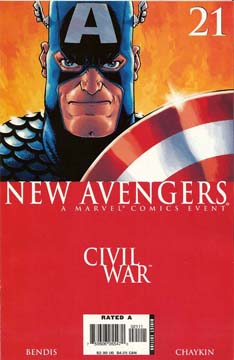 Howard Chaykin’s been quoted as saying that Captain America is one of the few characters he’d like to work on that he’d not had the chance to, yet. What most Cap fans would make of a story written by the creator of American Flagg or Black Kiss will (probably thankfully) remain a mystery, as in this case, he’s only on the art chores. Still, it’s fascinating to see one of Jim Steranko’s greatest disciples bring a bit of that old-school panache to the Cap of the 21st century.
Howard Chaykin’s been quoted as saying that Captain America is one of the few characters he’d like to work on that he’d not had the chance to, yet. What most Cap fans would make of a story written by the creator of American Flagg or Black Kiss will (probably thankfully) remain a mystery, as in this case, he’s only on the art chores. Still, it’s fascinating to see one of Jim Steranko’s greatest disciples bring a bit of that old-school panache to the Cap of the 21st century.
This is the first of four issues of New Avengers (with different guest artists) that will watch the team “Disassemble” in the wake of the Civil War. Writer Brian Bendis gives us a lot of interior monolog that, quite frankly, doesn’t sound much like Captain
Things pick up considerably when he’s joined by The Falcon. Like Ed Brubaker, Bendis has a good feel for the partnership of these two characters, allowing The Falcon to supply some of Cap’s missing emotional pieces. This issue takes place sometime prior to Civil War #2, as we see Cap and The Falcon begin to recruit potential resistance members. Once the two are in action, Bendis is on firmer ground with Cap, and even if their recruiting drive gets off to a shaky start, I’m intrigued to see what those next few issues bring.
Chaykin’s art has a brisk quality that feels fresh in some places, frankly rushed in others. He’s got more than a few visual tricks up his sleeve, though, and the action sequences are a delight (there’s one shot of Cap’s shield making contact with someone’s face that is half goofy fun, half outright “Ouch!”). His cartoony work is quite a contrast to the more realistic NA work of artists like Deodato or Finch, but it has a sense of gleeful excitement that no other artist on this title has yet matched.
In some way, New Avengers has been an interesting shakeup for a team whose entire history has been built on change; in other ways, it’s been a mess (Bendis is right when he says that he’s still just learning how to write a team book). But you don’t get a first-time pairing like Chaykin on Cap every day of the week—that alone makes the book worth checking out.
RATING: 
The Flash re-launches in a fourth incarnation with “The Fastest Man Alive”
By Graig
 1940: The Golden Age Flash appears in Flash Comics #1.
1940: The Golden Age Flash appears in Flash Comics #1.
1949: Jay Garrick gets cancelled with issue #104.
1956: The Silver Age Flash appears in Showcase #4
1959: Barry Allen’s adventures continue in The Flash #105 (picking up where Flash Comics left off). Wally West makes his first appearance as Kid Flash in the Flash #110.
1986: Barry dies in Crisis On Infinite Earths #8. Wally picks up the mantle in issue #12.
1987: Wally receives his own series, launching as the Flash #1.
1994: Bart Allan appears in the Flash #91 as Impulse.
2003: Bart becomes Kid Flash in Teen Titans #3
2006: Infinite Crisis hits and stuff happens. Wally disappears (the Flash ends with issue #230), Bart emerges from the future four years older, and Jay is the only super-speedster whose powers remain functioning. Apparently.
And one year later, this is where the Flash: The Fastest Man #1 alive picks up. Jay Garrick, the original Flash, is now the only Flash. Wally, his wife, and his twin children are missing, and Bart is suddenly 19 years old and powerless.
Jay is beginning to feel his age, and unable to tap into the Speed Force, he’s tiring. Bart. now practically an adult, has taken a scab job at an automotive plant and isolated himself from the superhero community, his own issues of abandonment brewing underneath. A scientist at S.T.A.R. labs has taken a heavy interest in Bart, in part because of the loss of his powers but also his rapid aging. But something isn’t right in the world of the Flashes and an explosion at the factory reveals that Bart’s been hiding secrets.
Steeped completely in its own mythology, this new series is really a shining example of what delineates DC from Marvel: legacy. Though the Infinite Crisis made it so that continuity doesn’t have to be nearly as tight, the Flash serves, and has served for decades, as the title and hero to deal with that concept of legacy. When the Silver Age Flash arrived, he took his title because he idolized Jay Garrick in the comics, and when Earths 1 and 2 collided he was able to meet his hero whom he though only a fictional character. Wally, when he took over the mantle, constantly felt in the shadow of his uncle but still forged his own legend. Bart only recently embraced his role as a part of that legend, but now it seems it’s his to have.
Danny Bilson and Paul DeMeo, the duo responsible for launching the Flash live action TV show back in 1990, handle writing chores for this new incarnation. It’s a surprising choice, especially considering they only really wrote two episodes of the series, but their interest and understanding of the characters in this first issue is evident (a retcon of Bart’s tutelage under Jay Garrick as opposed to Max Mercury not withstanding). Their dialogue is a little stiff at times, but flows nicely at others, however they havn’t yet found Bart’s voice for his inner monologue.
No less than four inkers on this first issue accentuate the art by Ken Lashley, and quite frankly it looks a mess. Lashley’s faces are often contorted awkwardly and generally look unpleasant and lacking in nuance, which hopefully a consistent inker will help correct in future issues.
Though not a particularly strong launch, the groundwork for the series is laid out, and it certainly seems to be running with what works best for the character. It has promise.
RATING: 
Frying Pan? Fire? DD gets a bit of both in Daredevil #86
By Jeb D.
 It’s time likes these I wish Stan Lee were here. Really, Stan the Man is the only person who could possibly do justice to this comic.
It’s time likes these I wish Stan Lee were here. Really, Stan the Man is the only person who could possibly do justice to this comic.
“Listen up, True Believer! Here it is—the battle you never thought you’d see. Matt Murdock stands shoulder to shoulder with his greatest foes! Ryker’s Prison is a powderkeg, and the match is lit! And is the ‘hero’ beside Murdock the most dangerous ally of all? Explosive action, double-crossing and death! Plus—which of Matt’s women has decided to re-enter his life at the worst possible time?”
One is tempted to say “all hyperbole aside”, but let’s face it—hyperbole is the Marvel way, and few books have earned it the way this one has. The Bendis/Maleev-Brubaker/Lark handoff was one of the most seamless I can recall, particularly since the new team took over, in effect, mid-story. And there’s no backing away—Brubaker has taken everything Bendis threw at Matt and ratcheted it up a notch. Lark’s got all of Maleev’s grit and realism with an even greater fluidity in the action scenes.
One tiny negative might be the David Finch cover, which is a gorgeous pinup that has only peripheral connection with what’s going on inside. Not that this is news at Marvel these days, but I had to look twice to make sure I hadn’t accidentally picked up an old reprint book.
If you’re following Daredevil, you’ve already devoured this issue. If you’re not, you really ought to be. Brubaker brings you up to speed just fine, and plunges you right into the heat of the action. Daredevil has been one of Marvel’s best titles since Bendis started his run five years ago; today, I’d say it lays clear claim to being THE best.
RATING: 
![]()

The Case Of Madeleine Smith
(NBM ComicsLit)
By
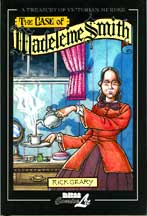 Rick Geary once again brings us a hard bound addition to his Treasure Of Victorian Murder series. These books give us a look into one of the areas that is both the darkest period in that time and of the human spirit. It illuminates how much society has changed yet remains the same from then to now. The Yin and Yang of life.
Rick Geary once again brings us a hard bound addition to his Treasure Of Victorian Murder series. These books give us a look into one of the areas that is both the darkest period in that time and of the human spirit. It illuminates how much society has changed yet remains the same from then to now. The Yin and Yang of life.
Geary has latched onto a section of time and subject matter that clearly appeals to his sense of what best demonstrates the mores and manners of society as they begin to be affected by changes in technology. As the Age Of Muscle begins to cede itself to the Age Of The Machine, the proprieties of a human scaled world submit to a machine based one. Some people became unhinged by the new pressures and the loss of customs. People in general became highly mobile, giving predators opportunities previously unavailable. Much of what plagues the modern world began here, and Geary gives the thoughtful reader a lot to consider.
This is the best constructed of this line of books, the most cinematic in its composition and cleverly staged. With a sense of irrevocable doom he leads you into a mind that is as dark and confused as one is likely to meet. This series is "branded" in a style that is immediately recognizable. The drawings maintain many of the quirky, idiosyncratic styling points that make Geary’s style so appealing. There is a detectable move toward a less cartoony style, a more "realistic" anatomical rendering than in his early work. All artists should experiment, and it is understandable that their style will move, in general, toward a more sophistication, certainly in the gifted artist toward what is more satisfying to himself. However the fan of Geary’s work must hope that what has made his work so appealing does not become lost over time.
Despite this very minor alteration in style, this is a wonderful book, assembled with style and taste, which reads with ease. It presents the great complications of human interaction with lessons and questions every reader should enjoy. Geary apparently spends a great deal of effort on a line of rubber stamps and post cards. No one would resent any financial gain such projects supply, but for his fans, any time taken from his fine series cannot be but resented.
RATING: 
(Ait/Planet Lar)
By Sean Fahey
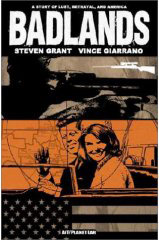 So much of the Kennedy assassination mythology is wrapped up in what amounts to little more than trivia. What was Oswald doing in
So much of the Kennedy assassination mythology is wrapped up in what amounts to little more than trivia. What was Oswald doing in
Similar to James Ellroy’s phenomenal novel ‘American Tabloid,’ Badlands does not concern itself so much with the actual assassination, but rather focuses on the foot soldiers that carried out the orders – the regular joes that, wittingly and unwittingly, allowed themselves to be drawn into a bad situation. Conrad Bremen, a recently released con, is one these foot soldiers, and through his unfortunate experiences Grant skillfully conveys the overwhelming sense of desperation and helplessness that would lead someone to become involved in a situation like this. At every turn,
Unfortunately, after the tragic events in
RATING: 
Shifting Sands Dusts Its Cheeks In Powdered Beauty: Krazy and Ignatz
(Fantagraphics Books)
By
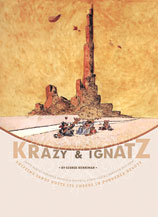 Every list that evaluates comic strips has Krazy Kat in the number one spot. Having a complicated origin from the earliest days of the newspaper strip, Krazy was the creation of George Herriman. In those early days, the artist was an employee of a particular paper, working in the paper’s building, and his job was to churn out the strips. A strip might last for only a short time, then the artist would begin an entirely new one with a completely original concept. The Kat or perhaps its ancestors were seen mostly as background figures with few if any comments in Lariet Pete, Bill Smith, Rosy’s Mama, Zoo Zoo, Alexander, Baron Mooch, and The Dingbat Family. Finally, in The Family Upstairs, a tale of apartment dwellers plagued by a noisy group that lives above them, a sub-strip appears with an attached story of a Kat and mouse living below and with them.
Every list that evaluates comic strips has Krazy Kat in the number one spot. Having a complicated origin from the earliest days of the newspaper strip, Krazy was the creation of George Herriman. In those early days, the artist was an employee of a particular paper, working in the paper’s building, and his job was to churn out the strips. A strip might last for only a short time, then the artist would begin an entirely new one with a completely original concept. The Kat or perhaps its ancestors were seen mostly as background figures with few if any comments in Lariet Pete, Bill Smith, Rosy’s Mama, Zoo Zoo, Alexander, Baron Mooch, and The Dingbat Family. Finally, in The Family Upstairs, a tale of apartment dwellers plagued by a noisy group that lives above them, a sub-strip appears with an attached story of a Kat and mouse living below and with them.
At that time the strips were enormous, with only about five strips fitted to a daily page. This is a great deal of space available for the artist to play with. As the Family’s popularity waned, the Kat’s grew and Herriman was able to give him a vertical and separate strip running down the edge of the page. This turned into the greatest of comic strips which ran from 1916 to 1944. The plot of the strip was quite simple, like all great art. The Kat loves the mouse. The mouse hates the Kat and demonstrates this by tossing bricks at the Kat. The Kat takes this as proof of the mouse’s love. The Dog loves the Kat and strives to ensure the mouse is prevented from throwing bricks or is properly punished for having done so. The combinations and ramifications are practically infinite. When a playful, astute, and original use of the language and dialects is included, the fact that this was the work of a true creative genius becomes readily apparent. By 1924, Gilbert Sheldon, a noted art critic of the time, included Krazy Kat in a book entitled The Seven Lively Arts, praising the strip and moving it in the minds of the public to a higher plane of appreciation, which it so roundly deserved.
An attempt to reprint all the Sunday strips (which originally occupied an entire page of the newspaper), was begun in 1988 by Eclipse Books. This effort lasted for eight volumes. In 2002 Fantagraphics Books took up where Eclipse left off and has now reached seven volumes in what should be recognized by all fans of comic books and strips as one of the most praiseworthy jobs in memory.
If there are faults, here it is that the books are soft bound, which must be considered more transient than hard bound, and that the strips are presented in a size smaller than the original. Very few publishers have put forward books that duplicated the original size of Sunday strips; one Tarzan, one Little Nemo, and a couple of Prince Valiant spring to mind. But these were quite expensive and have increased geometrically with passing time on the secondary market. The demand is probably not there for financial viability, but one can still dream. This is a series and publisher that has earned the complete support of the fan community. This is the cream of the crop and it is easily available. You have no one to blame but yourself if you miss it.
RATING: 
![]()

 Star Wars: Legacy # 1 (Dark Horse) – Another era in the Star Wars mythology begins. Taking place 150 years after the events of the first trilogy, Legacy finds the Star Wars universe once again threatened by the Sith, the evil masters of the dark side of the force. The Sith’s ‘rule of two’ has been disbanded, and their numbers have swelled. Combined with the remnants of the Galactic Empire, total domination is almost assured…oh wait, what’s that? A Skywalker? No way! That’s sure to put a wrench in the Sith’s dark plans. He’s a what? A pirate? Ah, so what. I’m confident that this Skywalker will eventually find his way and become the champion of light he’s destined to become. All kidding aside, Legacy # 1 is an exciting start to what looks to be an insane period of Star Wars history – one rich with bizarre characters, complex alliances and political intrigue (plus all the hyper-kinetic action we’ve come to expect from Star Wars). – Sean
Star Wars: Legacy # 1 (Dark Horse) – Another era in the Star Wars mythology begins. Taking place 150 years after the events of the first trilogy, Legacy finds the Star Wars universe once again threatened by the Sith, the evil masters of the dark side of the force. The Sith’s ‘rule of two’ has been disbanded, and their numbers have swelled. Combined with the remnants of the Galactic Empire, total domination is almost assured…oh wait, what’s that? A Skywalker? No way! That’s sure to put a wrench in the Sith’s dark plans. He’s a what? A pirate? Ah, so what. I’m confident that this Skywalker will eventually find his way and become the champion of light he’s destined to become. All kidding aside, Legacy # 1 is an exciting start to what looks to be an insane period of Star Wars history – one rich with bizarre characters, complex alliances and political intrigue (plus all the hyper-kinetic action we’ve come to expect from Star Wars). – Sean
RATING: 
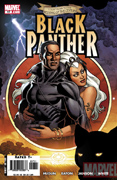 Black Panther #17 (Marvel) – Okay, so this was just a pretty silly issue. “Black Panther” #18 is the big, double-sized wedding issue, so that makes #17 the bachelor party one. As T’Challa is pretty humorous, his bachelor party – attended by the likes of the Thing, Prince Namor, Falcon, Luke Cage and organized by Wolverine (who suggests Madripoor over Rio, but eventually relents) – ending moments after he enters the first Brazilian strip club and feels that it’s beneath his dignity. So, where’s Storm in all this? Going on a shopping spree with Rogue and Sue Storm in
Black Panther #17 (Marvel) – Okay, so this was just a pretty silly issue. “Black Panther” #18 is the big, double-sized wedding issue, so that makes #17 the bachelor party one. As T’Challa is pretty humorous, his bachelor party – attended by the likes of the Thing, Prince Namor, Falcon, Luke Cage and organized by Wolverine (who suggests Madripoor over Rio, but eventually relents) – ending moments after he enters the first Brazilian strip club and feels that it’s beneath his dignity. So, where’s Storm in all this? Going on a shopping spree with Rogue and Sue Storm in
RATING: 
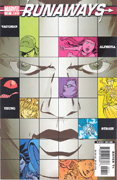 Runaways #17 (Marvel).
Runaways #17 (Marvel).
RATING: 
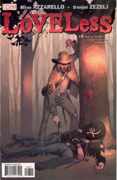 Loveless #8 (Vertigo) – Um…okay, perhaps it’s time to switch to trades on this one. It’s tough to throw in the towel on a western, but there’s a reason why “100 Bullets” is now a trade-only (if that) kind of text after being one of the best things out there for many years. This month’s issue of “Loveless” is a semi-origin type tale of Wes Cutter, the lead character of “Loveless” showing how he ran afoul of the blue-coat Yankees during the Civil War, paralleled with his new rein over the town of
Loveless #8 (Vertigo) – Um…okay, perhaps it’s time to switch to trades on this one. It’s tough to throw in the towel on a western, but there’s a reason why “100 Bullets” is now a trade-only (if that) kind of text after being one of the best things out there for many years. This month’s issue of “Loveless” is a semi-origin type tale of Wes Cutter, the lead character of “Loveless” showing how he ran afoul of the blue-coat Yankees during the Civil War, paralleled with his new rein over the town of
RATING: 
 Conan # 29 (Dark Horse) – Beginning with this issue, Hellboy creator Mike Mignola takes over the writing chores for a few months, lending his supernatural vibe to an adaptation of a Robert E. Howard story fragment “The Halls of the Dead.” Mignola’s Conan is much more stoic than Kurt Busiek’s interpretation. The dialogue is sparse, but direct, and this gives the character a more intimidating and iconic feel. Of course, when you have an artist like Cary Nord – who beyond being an exceptionally detailed penciller is also a phenomenal visual storyteller – you don’t really need that much dialogue to begin with. Classic sword and sorcery high adventure, with that creepy atmospheric Mignola touch. This issue is a great jumping-on point for anyone that is not already reading this book, one of the best being published. – Sean
Conan # 29 (Dark Horse) – Beginning with this issue, Hellboy creator Mike Mignola takes over the writing chores for a few months, lending his supernatural vibe to an adaptation of a Robert E. Howard story fragment “The Halls of the Dead.” Mignola’s Conan is much more stoic than Kurt Busiek’s interpretation. The dialogue is sparse, but direct, and this gives the character a more intimidating and iconic feel. Of course, when you have an artist like Cary Nord – who beyond being an exceptionally detailed penciller is also a phenomenal visual storyteller – you don’t really need that much dialogue to begin with. Classic sword and sorcery high adventure, with that creepy atmospheric Mignola touch. This issue is a great jumping-on point for anyone that is not already reading this book, one of the best being published. – Sean
RATING: 
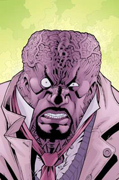 Invincible #33 (Image) – “Invincible” #33 is equal parts one of
Invincible #33 (Image) – “Invincible” #33 is equal parts one of